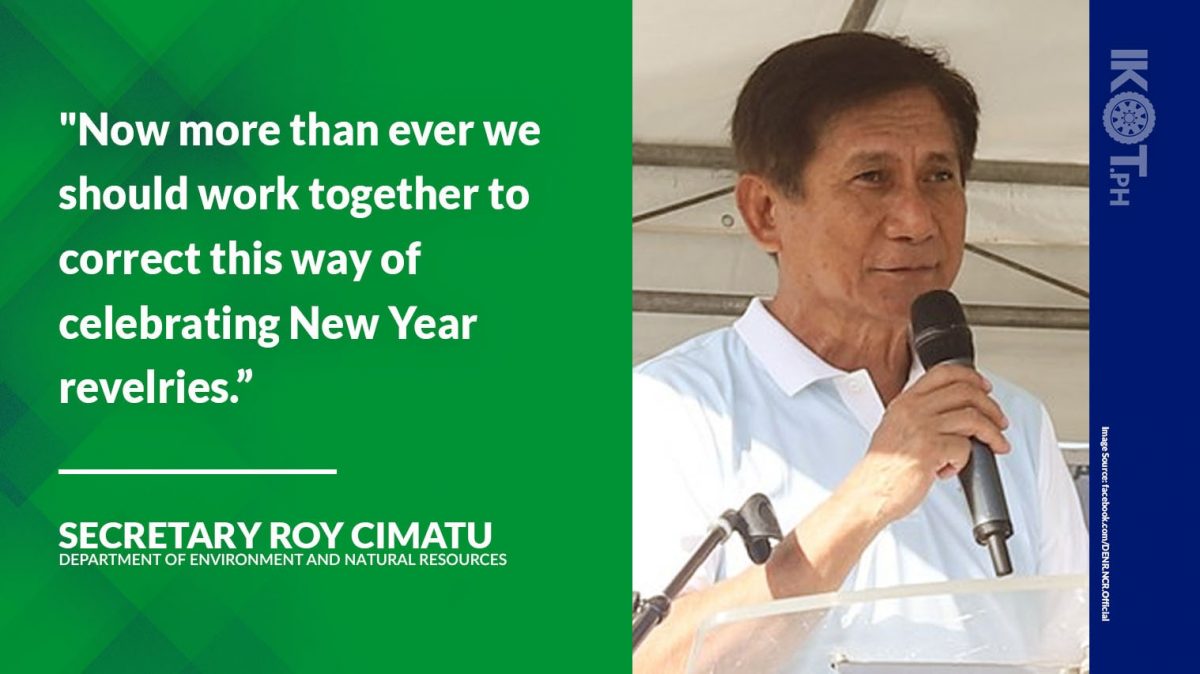The initial report of the Department of Environment and Natural Resources-Environmental Management Bureau (DENR-EMB) has shown that air pollution levels in two Metro Manila cities have exceeded the safe standards during the first two hours of January 1, 2022.
The DENR-EMB report showed that the air pollution levels in the cities of Marikina and Manila went beyond the standard of 150 micrograms per normal cubic meter (ug/Ncm) of particulate matter 10 or PM10.
Meanwhile, it is still conducting manual monitoring of 11 stations and is expected to come out with the laboratory analysis results soon.
“We are all aware of the pulmonary health risks these firecrackers carry.”
“Now more than ever we should work together to correct this way of celebrating New Year revelries as we are all aware of the pulmonary health risks these firecrackers carry,” DENR Secretary Roy Cimatu said.
To prevent spikes in air pollution levels, Cimatu encouraged the local government units to strictly enforce Executive Order No. 28 series of 2017 or the Regulation and Control of the Use of Firecrackers and Other Pyrotechnic Devices.
“Use alternative ways to welcome the New Year such as making noise with pots and pans and blowing party horns or trumpets.”
The environment chief also called on Filipinos to use alternative ways to welcome the New Year such as making noise with pots and pans and blowing party horns or trumpets.
PM10 in firecrackers consists mainly of residues of the explosive powders wrapped in paper which consists of a mixture of sulfur (S), carbon (C), and potassium nitrate (saltpeter, KNO3), and other fine minerals which contain heavy metals.
According to health experts, particles in PM2.5 are able to travel deeply into a person’s respiratory tract and can cause ill health effects and worsen the medical conditions of people with asthma or heart diseases.
Based on the data from the DENR-EMB, Marikina City’s PM10 peaked at 347 ug/NCM around 2 a.m. of January 1, 2022, with an average concentration of 271 ug/NCM monitored from 12 a.m. to 2 a.m., or a 215 percent increase compared to the 2021 New Year’s eve PM10 data.
In Manila, PM10 reached 156 ug/NCM between 1 a.m. and 2 a.m. but with an average concentration of 116 ug/NCM from 12 a.m. to 2 a.m., or a 68 percent increase compared to the 2021 New Year’s eve PM10 data.
The short-term limit for 24-Hour Averaging Time for PM10 is 150 ug/Ncm under the National Ambient Air Quality Guideline Value (NAAQGV) of Republic Act 8749 or the Clean Air Act.
For PM2.5, only the Manila monitoring station in Mehan Garden recorded a maximum concentration of 113 ug/Ncm and an average concentration of 84 ug/Ncm from 12 a.m. to 2 a.m. on January 1, 2022.
The reading accounts for a 71 percent increase from 49 ug/Ncm obtained during the same period in 2021.
The short-term limit for PM2.5 is 35 ug/Ncm under the NAAQGV.
Outside Metro Manila, five air quality monitoring stations (AQMS) recorded an increase in the average concentration of PM10 between 12 a.m. and 2 a.m. of January 1, 2022, compared to 2021.
These are the San Fernando City Station in Pampanga at 77 percent (from 86 ug/Ncm in 2021 to 152 ug/Ncm in 2022); Antipolo City Station at 188 percent (from 16 ug/Ncm in 2021 to 46 ug/Ncm in 2022); Biñan City Station at 27 percent (from 11 ug/Ncm in 2021 to 14 ug/Ncm in 2022); Puerto Princesa City Station at 34 percent (from 32 ug/Ncm in 2021 to 43 ug/Ncm in 2022) and Calinan, Davao City Station at 55 percent (from 20 ug/Ncm in 2021 to 31 ug/Ncm in 2022).
On the other hand, a drop in concentration of PM10 was recorded in the Zamboanga City Station at 22 percent (from 9 ug/Ncm in 2021 to 7 ug/Ncm in 2022); Iligan City Station at 3 percent (from 34 ug/Ncm in 2021 to 33 ug/Ncm in 2022); and Davao International Airport Station at 32 percent (from 25 ug/Ncm in 2021 to 17 ug/Ncm in 2022).
In terms of PM2.5 concentration, three air quality monitoring stations recorded an increase in the average concentration of PM2.5 from 12 a.m. to 2 a.m. of January 1, 2022, namely the Calinan, Davao City Station at 217 percent (from 6 ug/Ncm in 2021 to 19 ug/Ncm in 2022); Iligan City Station at 67 percent (from 15 ug/Ncm in 2021 to 25 ug/Ncm in 2022); and Zamboanga City Station at 13 percent (from 8 ug/Ncm in 2021 to 9 ug/Ncm in 2022).
Three AQMS recorded a decrease in the concentration of PM2.5 in the ambient air, namely the Puerto Princesa City Station at 46 percent (from 37 ug/Ncm in 2021 to 20 ug/Ncm in 2022), Davao International Airport, Davao City Station at 20 percent (from 10 ug/Ncm in 2021 to 8 ug/Ncm in 2022); and Sta. Rosa City, Laguna Station at 11 percent (from 27 ug/Ncm in 2021 to 24 ug/Ncm in 2022).


